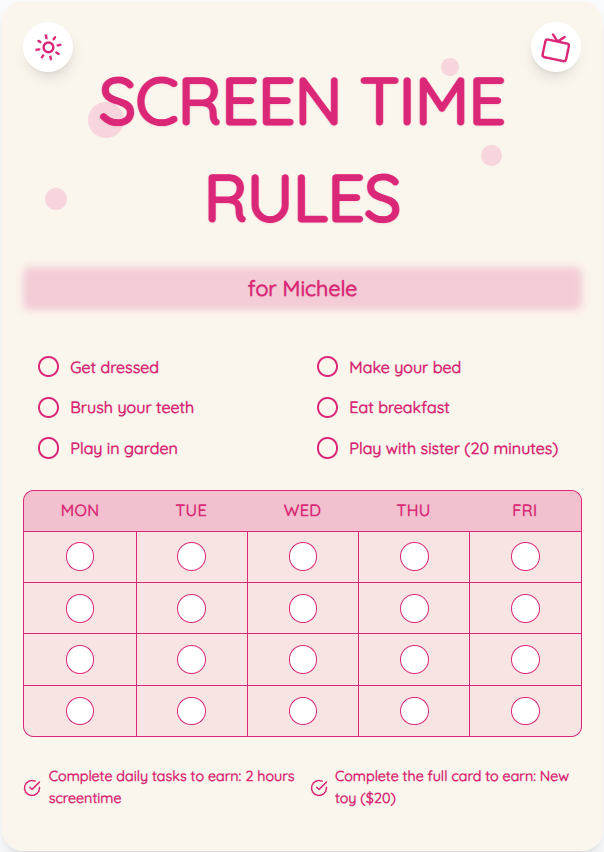Screen Time Recommendations by Age: Finding the Right Balance for Your Child
As a parent, navigating the digital landscape and setting screen time boundaries can be challenging. Understanding the recommended screen time limits by age is crucial for your child's development and well-being. Let's explore practical strategies to manage screen time effectively for children aged 2-12.
See What Your Screen Time Chart Will Look Like
Here's an example of a beautiful, customizable screen time rules chart you can create for your family

Understanding Screen Time Guidelines
Children's screen time needs evolve as they grow. For toddlers (2-5 years), the American Academy of Pediatrics recommends limiting screen time to one hour per day of high-quality programming. As children reach elementary school age, consider balancing screen time with other activities. Older kids may benefit from up to two hours of screen time, focusing on educational content and interactive programs.
Creating a Screen Time Routine
Establishing a consistent screen time schedule can help regulate your child's tech usage. Designate specific times for screen time, such as after homework or before bedtime. Encourage breaks during prolonged use and promote outdoor play and social interactions. Consistency is key to fostering healthy screen habits.
Put These Tips Into Action
Create a custom chart to implement these strategies with your child
Setting Screen Time Limits
Use screen time charts to set clear boundaries for your child. Allocate time for educational content, creative pursuits, and recreational activities. Encourage your child to be involved in setting limits, promoting responsibility and self-regulation. Be flexible when necessary, but prioritize real-world experiences over excessive screen time.
Monitoring Screen Time Effectively
Regularly monitor your child's screen time usage and adjust limits as needed. Use parental control tools to track usage and restrict access when necessary. Encourage open communication about online activities and teach digital literacy skills to promote safe and responsible screen time habits.
Practical Tips for Success
- Engage in screen time activities together as a family to bond and monitor content.
- Encourage physical activity and outdoor play to balance sedentary screen time.
- Create a technology-free zone in the house, such as during meals or before bedtime.
- Reward positive screen time behavior with non-tech incentives.
Frequently Asked Questions
How can I handle resistance to screen time limits?
Start by explaining the reasons behind the limits and involve your child in decision-making. Offer alternative activities and gradually reduce screen time to ease the transition.
Are educational apps considered part of screen time limits?
Educational apps can be included in the allotted screen time, but ensure they are age-appropriate and offer valuable learning experiences.
Should I completely ban screens for young children?
While moderation is key, complete avoidance may not be practical. Focus on quality content and supervised usage to make screen time a positive experience.
Finding the right balance in managing your child's screen time is essential for their overall well-being and development. By following age-appropriate recommendations, implementing practical tips, and fostering open communication, you can create a healthy tech environment for your family. Explore our screen time charts to simplify the process and promote positive screen habits.
Ready to Transform Your Family's Screen Time?
Join thousands of parents who have successfully managed screen time with our customizable charts.
